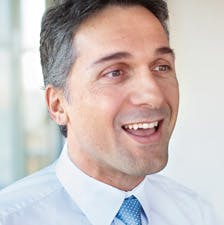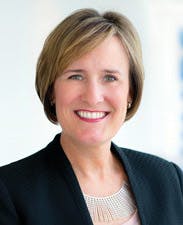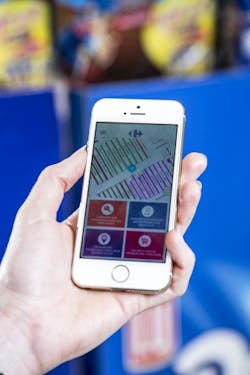MAURY WRIGHT interviews ERIC RONDOLAT, CEO of Philips Lighting, and AMY HUNTINGTON, president of Philips Lighting Americas, at LightFair International (LFI) on the company's business strategy and technology direction.
LEDs Magazine: Royal Philips is moving ahead with its planned divestiture of Philips Lighting after completing the Lumileds divestiture. Most recently, Royal Philips said the initial step for Philips Lighting would be an initial public offering (IPO) for a minority stake, with Royal Philips maintaining a majority stake in Philips Lighting. It seems like the parent company believes in lighting but simply sees the need to separate what are truly divergent businesses in lighting and healthcare.
Eric Rondolat (ER): We announced, in September last year, the separation process. And we are on track. It will take place at the end of this year. The main reason is increased focus for both businesses - on the healthcare segment as well as the lighting business.
LEDs:Osram made major business news recently, announcing it planned to divest its lamps business. Philips Lighting is a major innovator in LED-based retrofit lamps. How do lamps fit in?
ER: I think our strategy is very clear. We decided to divest the components part of the business, because we believed it's a business that is more global where there is the need of scale. So the upstream part of the business has been divested. [Lumileds] will be a winner in that space, continuing to have a relationship with Philips Lighting.
Then we said we believe in products, systems, and services as part of our portfolio, being at this point in time the leader in the [lighting] industry... Good products make good systems. And when you have implemented the systems, then you have unlimited [opportunity] to offer services.
LEDs: About services, do you mean projects such as the Schiphol Airport service project in Amsterdam? Is that the first major services deal for Philips Lighting?
ER: That one is public and we have had a few others. But it depends on which type of service you are talking about. [The Schiphol project] is the pay-for-lux type service. The customer doesn't pay you for lighting being implemented but pays you for the usage of light. But there are many other types of services. There can be maintenance contracts over a very long period of time. And we have done that on many different occasions, in many different places in the world, not only the mature countries but in many, many emerging markets.
We have products, and that's fine; we want to continue selling products. You put all of those products together - light sources, fixtures, with the control and the software which is adapted to the customer application that you targeted - and this is the system. So far, I'm talking payback. And connectivity is enabling this system. And we strongly believe in connectivity. When this is done, then you can be present on this full lifecycle.
[For example], on the Tappan Zee Bridge [a project announced during LFI; see rendering below] we get online all of the information about the architectural lighting and the street lighting. And then getting this information, we [can] go back to the customer and offer additional functionalities. So when we talk about services, it's about our ability to be present on the full lifecycle. So it can be pay-for-lux, but it can also take many different forms and shapes.
Philips Lighting recently announced its cooperation on the Tappan Zee bridge project, for which it will provide architectural and street lighting as well as controls.
Amy Huntington (AH): It's helping the customer understand the utilization of their space that's lit. With sensors in the luminaires, the services derive from the data that can be harvested from the digital lighting system - so [there are] a lot of new opportunities. And with the Tappan Zee Bridge we have a great example.
LEDs: What new technology are you using on the bridge?
AH: Active Site is the cloud-based lighting system that controls our architectural product family from Philips Color Kinetics (CK). It allows for remote programming, troubleshooting, seamless updating, software as a service, potentially. We could have programming, either us or our partners to change scenes programmed dynamically.
Active Site was used on Madison Square Garden, when we relit the exterior of the Garden. And then the Tappan Zee Bridge will have 2700 Color Kinetics fixtures and 500 of our RoadView luminaires, with the road lighting controlled by CityTouch and the architectural CK luminaires controlled by Active Site. But what's unique in this application is that we've ported all of the data into one dashboard. So the owners of the Tappan Zee Bridge will have the most sophisticated bridge in North America with control of both lighting systems through one dashboard.
LEDs: On the bridge, you can monitor the operation of the lights for automated maintenance. What else? Are we talking monitoring traffic flow?
ER: We can enable, at the light pole level, the gathering of that type of information. We would not directly deal with [that data] because it is not our business. Traffic flow, pollution monitoring, that's not our business, but we can help to gather that information.
But I will give you another example. In an office space [consider] office lighting powered over Ethernet [using Power over Ethernet (PoE) technology]. At the same time we have sensors that are sensing temperature and occupancy. In the long run, giving back this information to the customer helps them to understand [space utilization]. [For instance] in Amsterdam they can free up two additional floors that they can rent [in the Deloitte building]. That's a fabulous additional capability. And this is what we call services - how do you monitor the installation for the full lifecycle and significantly improve it.
If you want to be sustainably delivering energy efficiency and performance, you need to monitor, and monitor all of the time, and improve incrementally all of the time. We've seen many instances where you do a big effort in one stage and then you let it go and you don't monitor it. Two or three years later, you realize that you've gone off rail and you need to do another campaign. So the idea is to be totally monitoring and constantly improving.
LEDs: Is Active Site new? We haven't heard that brand name before.
AH: Active Site, we're rolling that out now, it's being commercialized now. There are some of our active CK installations [that we have used to] develop it. We’re commercializing it because it offers those benefits of remote programming, troubleshooting, seamless updating. And then on the CityTouch side, the world has been our laboratory. We have 262 projects globally in 31 countries.
What we are showing here [at LFI] is the next evolution, which is the mobile- and cloud-based Connector Node. I know you are familiar with Los Angeles (LA), which was our ability to come in and protect their investment that they had already made in LED luminaires, even though they were not ours. We are able to connect the nodes through the NEMA socket and allow for the mobile connectivity, instant commissioning [Philips recently announced the LA project].
My favorite story is when they were showing the technology to one of the [street-light maintenance personnel in the city of LA], they put one in a box and they had the maintenance guy go out to the site and plug it in, and on his cellphone call [the management system] - and within three minutes, that luminaire had self-recognized and was now part of the system. It's instantaneous recognition.
LEDs: The LA market situation has been confusing in terms of the controls story. Several years ago, they were working with the Acuity Roam system. Later, GE Lighting claimed it had won the control business in Los Angeles.
AH: There will be no ifs, ands, or buts about it. Of the 215,000 lights in LA, 155,000 are LED. Of that 155,000, 110,000 will be connected via this Connector Node. So 71% of their LED street lights will be connected with the Connector Node. [The roll-out] starts in June, and it will roll out through the rest of the year. It's exciting for us because LA is an innovative city.
LEDs: The Connector Node and the GSM-mobile-based interconnect scheme were never really announced by Philips as products. You simply sprung the LA project on everyone. Was the product developed for Los Angeles or has it been in the works?
AH: It really wasn't launched like here's [a product]. It was with this installation. I like the opportunities we have to tell a story, and so we are telling the story of the city of LA enabled by the Connector Node.
ER: It's an architecture that we've been working on for two years. The first time we made it public was September last year.
LEDs: How many ideas will come from Philips, in terms of services, relative to how many will come from the customer? And how do you engage with customers?
ER: In the specific case of the Amsterdam POE project, we had the technology. We had the ideas and business models. But then we understood that we could bring to our customer a lot of additional benefits. We're talking about the customer seeing all of the opportunities after we implement the system. We've been learning. We've been listening a lot. And we've been optimizing the functionality.
LEDs: But your offerings go way beyond the commercial space, and some of your most compelling control technology is targeted more at the home.
ER: We've been optimizing the functionality we bring to customers in the home, too. We started with colored bulbs, but when you talk about Hue it's a full ecosystem of light in your home. And it's not a gimmick. We can really bring additional benefits - what about when the Nest security device goes off that the lights turn red. That's a use case that becomes [a very important feature] at a point in time. All of those things we learn from the customer, listening to them while you develop the system.
LEDs: In terms of controls, where does PoE fit? And how do you reconcile the many different types of networks that you offer? PoE may work in new construction, but wireless is required in many places.
ER: You have the new building and you have the retrofit building. In the retrofit building, when you take off the ceiling, the lighting is like it's a new building. When you only change the fixtures, it's pure retrofit. You would see that the wired application such as PoE would probably work for totally new but also for retrofit when you take off the ceiling, and you put an entirely new architecture in place.
Nevertheless, we believe that you need to have different architectures. We believe in wireless for a given part of the market and applications, and we believe in wired. We are not obsessing that it has to be PoE - no. PoE is great for some applications and wireless is great for others, so we need to have the two technologies. And by the way, we have them, for example, in SpaceWise.
AH: I would add to that [we advocate] a hybrid approach relative to plumbing, but a common use interface so that the software can get adapted at the user interface whether you use wired, wireless, or PoE. SpaceWise is the wireless retrofit [platform]. Up to 50 luminaires in a space can be controlled by a remote control. The lighting is powered by the mains but uses a wireless control technology. It is ZigBee based.
LEDs: How long has the PoE installation been running in Amsterdam and have there been technical glitches?
ER: A year, I think, give or take. It's occupied. [The network] is running with [no major problems]. They are in the space. They have a YouTube video, they talk about that space, they talk about the lighting. It is quite cool. Now they have more and more tenants going into the space.
LEDs: If we can look forward a year, what is going to change for you in 12 months?
ER: Not much. We have a strategy. We've been working on it extremely hard for the past three years. Our strategy is very clear, from products to products in systems to services. What is important is [for us to execute] in the segments we have selected - home, retail, office, industry, and public. We develop for all these customer segments and applications including PoE, wired, and wireless connectivity.
I can talk about street lighting; we have the wired, a simple architecture. Then we have CityTouch wired and CityTouch wireless. [In wireless], we put a GSM feature on the lighting fixture and then send all of the information back to the IR backbone.
We have the three architectures in front of us that are dependent on the type of site in front of us and the type of customer. We do that on and on. For retail we talk about indoor positioning and all of the other architectures we have developed for retail. When we are in front of retail customers, hey, we are going to talk about how we improve your business. First it's energy efficiency, and that's very basic. Then it's beyond energy efficiency. What are we bringing? In retail, it's revenue enhancements. In office space, it's increased productivity. In road and street it's less crimes, less accidents, and a better identity of the situation on top of energy efficiency.
This is where we are. In 12 months we'll be pushing that and implementing it every day as we speak.
LEDs: You mentioned indoor positioning; where are you in terms of deployment?
ER: We've been working on that technology for many years now. We have running pilot sites in many different places, and many different application areas. We have museums in the Netherlands where you put your smart device under the light that is near the painting and you get all of the information about the painting - far more than what you can get in audio guides. Then you can decide what you want to do. You can spend twenty minutes in front of the painting or perhaps a half second.
Also, we are developing applications in retail spaces. We are going to be announcing in the coming weeks a roll-out in the retail space. This is a serious big store, a serious trial.
[Editor's note: After this issue of the magazine went to press, Philips Lighting announced its retail partnership with Carrefour involving indoor location services.]
Philips Lighting has announced its retail partnership with Carrefour involving indoor location services.
AH: Realize also that when you achieve it with visible light communications (VLC), that [the implementation] is in the edge of the network. That's what enables personal control of a fixture using the iPhone.
ER: Right, we use that VLC feature in the edge. It's not only in retail. At your desk, you can put your smart device under the light. It provides full control of the lighting space. It's also in many other applications that we are looking at.
LEDs: But you could handle the office application that you describe by simply detecting the IP address of the mobile device that a worker is carrying.
ER: The problem that you have, it's not un-doable, but you need another architecture. It depends on where the phone is and ultimately recognizing it. The beauty of the lighting architecture is on many different levels. It's very, very accurate in terms of positioning, better than any other system. You know exactly where you are.
And at the same time, from the privacy standpoint, you aren't being monitored all of the time. First, it's mono-directional from the light to the phone. And second, you are only seen when you want to be seen. You don't need to be geo-positioned all of the time, only when you need it. When you need to be geo-positioned is when there is something interesting or a promotion in your retail shop.
At the same time, if you are at your desk and you want to be controlling your space,that is when you want to be geo-positioned. The transfer of data resulting is minimal. It's only activated when you need it.









